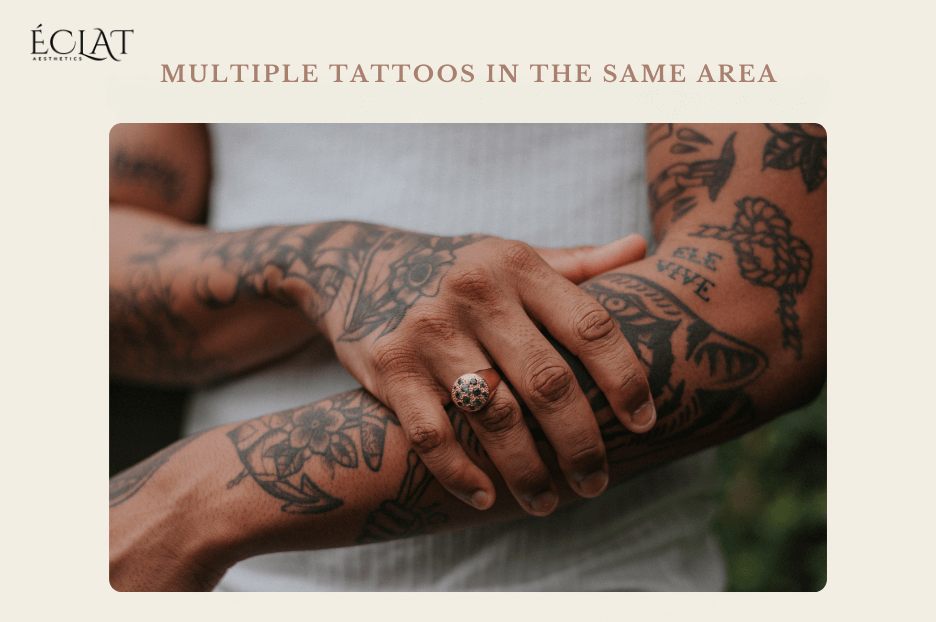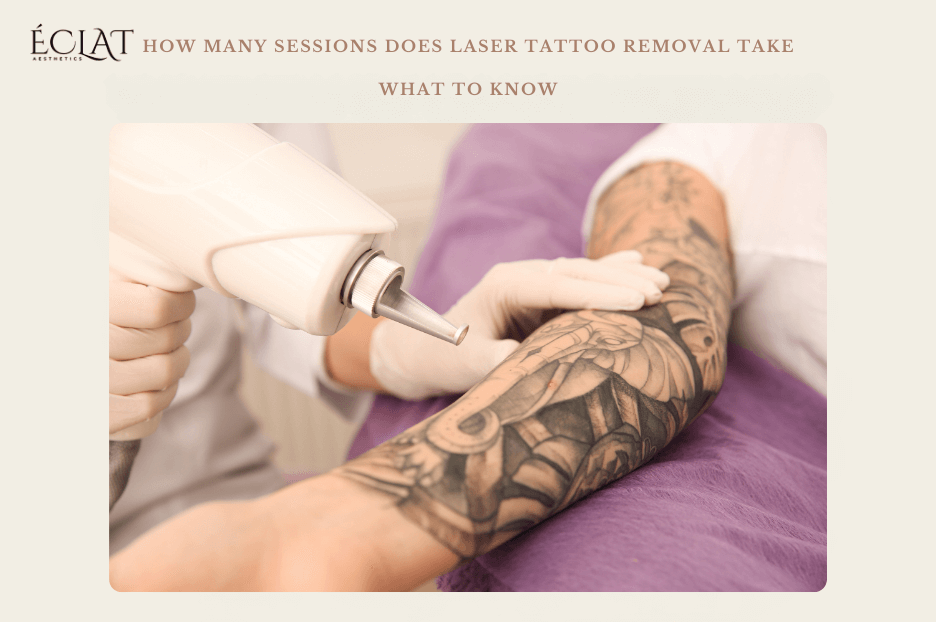Unwanted tattoos can feel like permanent reminders of a time, place, or decision that no longer reflects who you are today. Maybe it’s a design that’s faded awkwardly over the years, a name you wish to move on from, or a spontaneous piece that simply doesn’t fit your current style. Whatever the reason, you’re not alone, thousands of people choose laser tattoo removal every year to reclaim their skin and start fresh.
The exciting part is that modern laser technology has transformed tattoo removal from a risky, painful procedure into a safe, precise, and highly effective option. At ÉCLAT Medical Aesthetics in Alpharetta, GA, we help clients navigate this process with clarity, realistic expectations, and top-tier care. In this guide, we’ll explore exactly how many sessions you might need, what factors influence the timeline, how the treatment works, and what you can expect along the way, so you can step into your next chapter with confidence.
Factors That Determine Session Count
Deciding how many laser sessions a tattoo will require is never an exact science, it’s a tailored estimate based on the tattoo itself and the person who wears it. Below is a comprehensive, expanded guide that explains the variables we evaluate at Éclat Medical Aesthetics and what they typically mean for your treatment plan.
Tattoo Characteristics
Size & Coverage
- Small tattoos: (tiny symbols, short words) generally need fewer sessions because there’s less ink to break up.
- Medium and large pieces: require more sessions due to greater surface area and deeper ink in places.
- Dense coverage: such as solid black fills or saturated color blocks takes longer to clear than linework or shaded areas.
- Multiple tattoos in the same area: can extend the overall process because the cumulative ink load is higher and tissue needs more recovery time.

Age of the Tattoo
- Older tattoos (10+ years): often respond better: ink naturally breaks down over time and can be easier for lasers to fragment.
- Recently healed tattoos: (less than a year) may be more challenging because newer ink can sit deeper in the dermis.
- Well-healed, mature tattoos: tend to respond more predictably than very recent work.
Ink Colors
- Black and dark blue: usually the easiest to fade — many clients see major improvement within 4–8 sessions.
- Reds and oranges: moderately responsive, often taking somewhat longer (commonly 6–10 sessions).
- Greens, yellows, and fluorescent pigments: among the most difficult to remove and may require many more sessions (often 8–15+).
- Multicolor tattoos: require a strategy that targets each color (sometimes with different wavelengths or laser types) and therefore generally take longer.

Note: Exact session counts by color are approximations. A consultation and test spot are the best ways to refine expectations.
Ink Quality & Density
- Professional tattoos: commonly use denser, higher-quality pigments; while they’re neat and consistent, the density can require more sessions to clear.
- Amateur tattoos: or those done with cheaper inks sometimes clear faster because pigment sits less deeply or is less concentrated.
- Layered or cover-up tattoos: are among the most complex: older ink under newer ink increases pigment load and often needs 12–20+ sessions, sometimes across different laser wavelengths.
Curious About Your Session Count?
Find out exactly how many sessions your tattoo might need. Book your expert assessment today and get a personalized plan designed for your tattoo and skin type
Individual Factors
Skin Type & Color
- Lighter skin tones: often permit stronger energy settings and may respond faster with lower risk of pigment changes.
- Darker skin tones: require a more cautious approach to avoid post-inflammatory hyperpigmentation or hypopigmentation, which may mean more sessions at lower settings.
- Skin thickness: and the location of pigment within the dermis also influence how effectively the laser energy is absorbed and how quickly the body clears the fragments.
Location on the Body
- High-circulation areas: (face, neck, upper chest) typically heal and clear ink faster because lymphatic and blood flow help remove ink fragments.
- Extremities: (hands, feet, ankles) and areas with poorer circulation often require more sessions and more time between them.
- Areas with thicker skin: (elbows, heels) sometimes need extra treatments since penetration and dispersion differ.
Overall Health & Lifestyle
- Circulation & fitness: better circulation and regular exercise speed removal by aiding lymphatic drainage.
- Smoking: nicotine constricts blood vessels and slows removal — smokers often experience slower progress.
- Immune function: a robust immune system removes laser-fragmented pigment faster.
- Age and general health: younger, healthier bodies generally heal quicker, though individual variation is large.

Session Breakdown by Tattoo Type (Expanded Estimates)
Simple Black Tattoos
- Small text or symbols: typically, 4–6 sessions.
- Medium designs: often 6–8 sessions.
- Large pieces: commonly 8–12 sessions depending on density.
Multi-Colored Tattoos
- Small colorful pieces: 6–10 sessions.
- Medium complex designs: 8–12 sessions.
- Large, vibrant tattoos: 10–15+ sessions; some colors might require additional passes or alternative wavelengths.
Cover-Up / Layered Tattoos
- Frequently: 12–20+ sessions.
- May require staged approaches (focus on dark layers first, then target underlying colors).
- Complex planning often involves alternating lasers or combining modalities.
What to Expect at Your Consultation
At your initial visit, we will:
- Examine the tattoo: (size, color, depth, scarring).
- Review your medical history: and lifestyle factors (smoking, medications, immune conditions).
- Discuss realistic goals: complete removal vs. lightening for a cover or modification.
- Recommend a laser plan: including likely wavelengths, number of sessions (range), and spacing.
- Perform a test spot: if needed to see how your skin and ink respond.
- Provide written pre- and post-care instructions and a cost estimate.
What to Expect During the Process
Initial Sessions (1–3)
- The tattoo may appear darker immediately after treatment (a temporary oxidation effect).
- Visible fading is often minimal in the first couple of sessions.
- You may see short-lived whitening (frosting), redness, or mild swelling which resolves during healing.
Middle Sessions (4–8)
- Noticeable fading becomes increasingly visible; outlines blur and colors lighten.
- Multi-stage color shifts occur as certain pigments break down sooner than others.
- Progress is often visible to friends and family at this stage.
Final Sessions (8–12+)
- Focus shifts to fine-tuning stubborn areas and addressing residual color or ghosting.
- Many tattoos reach significant to near-complete clearance, though some faint shadowing can persist depending on prior scarring and ink depth.
Timeline Considerations
Treatment Intervals
- Sessions must be spaced at least 6–8 weeks apart to allow the body time to clear fragmented pigment and for skin to recover.
- Shortening intervals compromises efficacy and raises the risk of side effects like scarring or pigment changes.
- Some anatomical areas require longer healing windows before the next session.
Total Timeline
- Typical range: complete or near-complete removal often takes 12–24 months from the first session to final follow-up.
- Complex pieces: (large, multicolor, cover-ups) can extend to 2–3 years.
- Patience and proper spacing are essential for both safety and maximum clearance.
Realistic Expectations
Complete vs Significant Fading
- Many tattoos can achieve 95%+ clearance, especially black or dark-blue work treated with modern Q-switched or picosecond lasers.
- Others achieve 85–95% fading, which is cosmetically satisfactory for most clients.
- Ghosting (a faint residual shadow) or slight changes in skin texture may remain in some cases, particularly where prior scarring or deep pigment exists.
Individual Variation
- Response times vary widely. Two people with similar tattoos can experience very different courses.
- We reassess progress after each session and adjust the plan to optimize outcomes.
Practical Aftercare & Lifestyle Tips
Between Sessions
- Keep the area clean and moisturized.
- Avoid sun exposure; use broad-spectrum sunscreen (SPF 30+) or cover the area.
- Do not smoke or use nicotine (including vapes) in the treatment period.
- Follow all aftercare (dressings, ointments, activity restrictions) provided by your clinician.
- Avoid picking or scratching any scabs or crusts that form.
Lifestyle Factors That Help
- Stay hydrated and eat nutrient-rich foods to support healing.
- Regular exercise enhances circulation and lymphatic drainage.
- Adequate sleep and stress-reduction practices help immune function.
- Avoid blood-thinning medications or supplements (aspirin, fish oil) before sessions unless cleared by your clinician or physician.
Beginning Your Tattoo Removal Journey
The path to tattoo-free skin is a gradual process that combines science, skill, and patience. While the number of sessions varies, most clients find the experience rewarding as they watch unwanted ink fade away over time. At ÉCLAT Medical Aesthetics in Alpharetta, GA, we’re here to guide you every step of the way offering advanced technology, expert care, and a supportive environment where your goals are the priority.
When you’re ready to start, schedule a consultation with our team. Together, we’ll create a plan that works for your tattoo, your skin, and your timeline so you can look in the mirror and see only the art you choose to keep.
Ready to See Your Ink Fade?
Take the first step toward the skin you want. Book your personalized tattoo removal consultation at ÉCLAT Medical Aesthetics today and discover how our advanced technology can help your unwanted ink fade session by session.
Frequently Asked Questions
How many sessions will I need to remove my tattoo?
The number of sessions depends on your tattoo’s size, colors, ink density, age, and location, as well as your skin type and overall health. On average, most tattoos require between 6–12 sessions, while more complex, multi-colored, or cover-up tattoos can take 12–20+ sessions. During your consultation at Éclat Medical Aesthetics, we’ll give you a personalized estimate based on your unique tattoo.
Does laser tattoo removal hurt?
Most clients describe the sensation as like a rubber band snapping against the skin. The discomfort is brief and manageable, and we offer topical numbing and other comfort measures to make your session as easy as possible.
Can all tattoo colors be removed?
Black and dark blue inks respond the fastest, while reds, oranges, greens, and yellows can take more sessions. Some pigments, especially neon or white, are more challenging, but our advanced multi-wavelength laser technology is designed to target a wide range of colors for the best possible results.
How soon will I see results from tattoo removal?
Fading usually becomes noticeable after 3–4 sessions, but the process is gradual. Every treatment breaks down more pigment, which your body’s immune system then clears over several weeks. Patience is key for safe, effective results.

